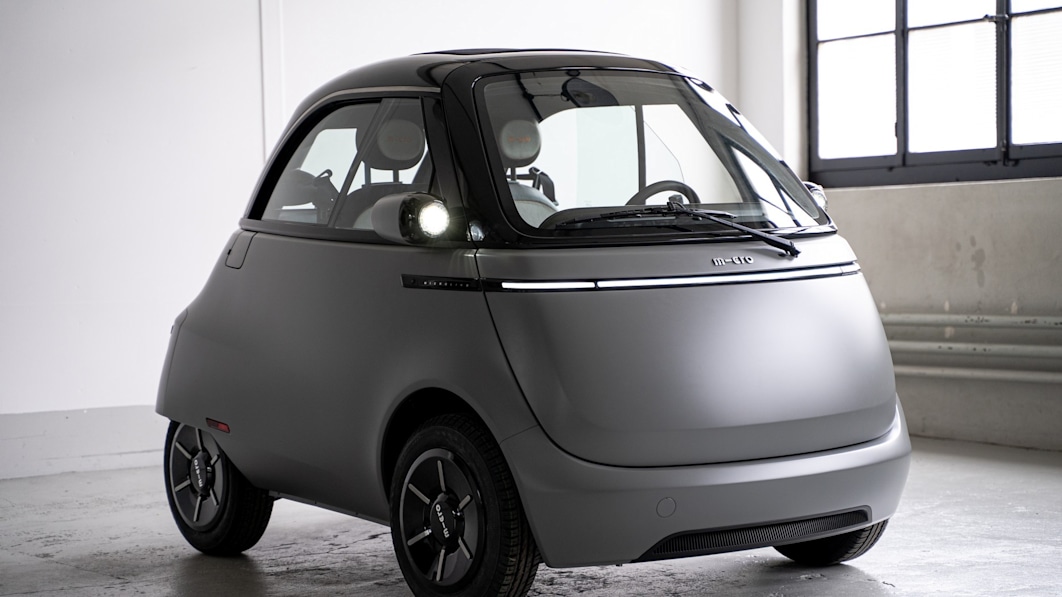
Earlier this year, the Micro Mobility Company out of Switzerland announced that after four years of successes, challenges, and failures it had developed its Microlino bubble car electric vehicle into Microlino 2.0. The aim was to get its five prototypes out testing and through the regulatory approval process in Europe, reaching series production by September. This last stretch has taken just a tad longer, but Micro has finally showed the production Microlino 2.0 and expects to get assembly lines running at its dedicated facility in Turin, Italy, before the end of the year.
When we saw the first Microlino in 2016, the BMW Isetta-inspired city car was built with a stamped steel tub supporting a tube frame glasshouse, used a pushrod suspension in front and a rigid axle in back, and plans to offer two battery packs providing 78 and 125 miles of range using a rear-mounted e-motor. Microlino 2.0 gets a pressed-steel and aluminum unibody for a stiffer, safer bodyshell, the company saying this is the first micro EV to get automotive-grade construction; MacPherson struts at all four wheels for a much better ride; and three battery pack options, the largest providing 143 miles of range on the European cycle.
The steering column has been switched from a detachable unit connected to the front door to a fixed, inseparable unit. The outside door handle is gone, replaced by a pushbutton. The 12.5-kW (17 hp) e-motor with 87 pound-feet of torque hits a peak 19-kW (25 hp), getting the runt up to 90 kilometers per hour (56 mph), and company CTO Peter Mueller said the powertrain is now 10% more efficient. Acceleration from standstill to 50 km/h (31 mph) takes a claimed five seconds.
There will be three trims, staring with Urban, costing 12,000 euros ($14,787 U.S.) and configurable in either Amsterdam Orange or Santorini White with a gloss black roof. The interior fabric comes in either black or anthracite (gray). The Dolce adds chrome trim outside and the option of Milano Red, Paris Mint, or Zurich Blue exterior colors with a white roof and a standard folding sunroof. The Dolce also adds Infinity LED light bars front and back to accompany the standard lights, and wraps its interior in fabric and vegan leather. The top trim Competizione switches the color palette to matte, in either Gotham Anthracite, London Green, or Torino Aluminum, paired with a gloss black roof and folding sunroof.
The three battery packs start with a 6-kWh unit able to power a 95-kilometer range (59 miles), a 10.5-kWh unit good for 175 km (109 miles), and a 14-kWh pack able to go 230 km (143 miles). All trims can be ordered with any battery. Charging to 80% capacity is said to take four hours for the two smaller units and three hours for the largest unit when plugged into a standard European 220V household socket.
Claimed weight is 435 kilograms (950 pounds) without a battery, or 513 kilograms (1,131 pounds) likely with the smallest battery. The interior fits two people on the bench seat, and their 203 liters (8.1 cubic feet) of cargo — about “three crates of beer,” we’re told.
With 24,000 reservations on the books, Micro Mobility might want to increase production from its planned 7,500-unit annual plan as soon as possible. Especially because the company already has a three-wheeled scooter called the Microletta aiming for an early 2022 release, and a three-wheeled scooter called the Gladiator being considered for production. The first Microlino 2.0 deliveries will be made in Switzerland, followed Germany and then the rest of Europe.
